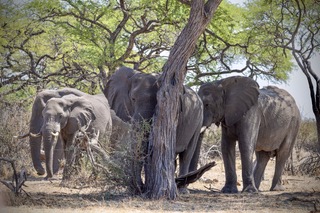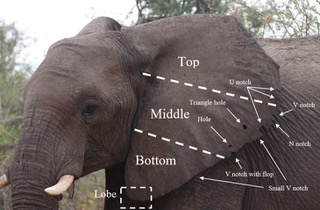
Congratulations Simon!
December 6, 2024
Getting WILD with the Australian Broadcasting Corporation (ABC)
April 7, 2025Tracking Giants: Discovering the Movements and Social Lives of Male Elephants


The African savannah elephant, a keystone species and ecosystem engineer, faces an increasingly fragmented world. Historical estimates suggest that today’s population—approximately 400,000 individuals—represents only about 2% of what existed two centuries ago. With around 130,000 elephants, Botswana is home to roughly one-third of the remaining population, underscoring its pivotal role in conservation efforts. However, despite the vast expanse of protected areas such as the Makgadikgadi and Nxai Pans National Parks, research shows that elephants spend considerable time outside these protected spaces. This behaviour highlights the critical need for functional wildlife corridors to ensure their long-term survival and reduce human-wildlife conflict.
A recent study by our affiliated Master’s student, Simon Isacsson, on the social dynamics of male elephants has revealed key insights into their behaviour. Using photo-identification and mark-recapture methods, he tracked individual bulls over time. Photo-identification, a noninvasive technique, allows scientists to recognise individuals based on unique physical traits such as tusk shape, ear notches, and facial wrinkles. Since 2012, Elephants for Africa has identified 1,391 unique bull elephants in the Makgadikgadi and Nxai Pans National Parks, forming the foundation of this study.
The results indicate that bulls spend approximately 26% of their time within our study site, with time away from the study site increasing during the wet season. Younger males exhibit greater mobility, potentially increasing their risk of encountering human settlements. He also investigated who individual elephants were choosing to spend time with and whilst elephant bull social associations are generally short-term, some individuals maintain long-term companions, a finding that adds nuance to our understanding of male elephant social structures.

Elephants, as wide-ranging herbivores, require extensive landscapes to meet their ecological needs. However, habitat fragmentation and loss have drastically reduced their historical range to less than 15%. National parks alone cannot provide the space or resources necessary to sustain healthy elephant populations, making connectivity between protected areas vital.
These data reinforce the importance of wildlife corridors—landscapes that facilitate safe movement between protected areas. These corridors reduce the likelihood of human-elephant conflict by steering elephants away from high-risk zones, such as farmlands and densely populated regions. Additionally, maintaining connectivity supports genetic diversity and allows elephants to access seasonal resources critical for their survival.
Previous studies by our affiliated researchers, such as Dr Connie Allen and Gus Pitfield, as well as our long-term monitoring, have highlighted the important role of older male elephants in male elephant society. Older males appear to play a stabilising role, potentially curbing risky behaviour in younger males. Conservation strategies that prioritise the protection of older bulls may, therefore, may offer a natural means of conflict mitigation.
Understanding elephant movement and social dynamics is essential for developing effective conservation strategies. As human populations expand and landscapes become increasingly fragmented, proactive measures must be taken to ensure elephants have the necessary space. This means securing and maintaining wildlife corridors, fostering coexistence initiatives, and supporting research that deepens our understanding of the complexities of elephant behaviour.
By combining rigorous research with practical conservation solutions, we are forging a future where elephants continue to roam freely across Botswana’s landscapes. The challenges ahead are significant, but with science-driven strategies, collaboration, and decisive action, we can secure the future of this keystone species, ensuring they remain a defining presence in Africa’s wild spaces for generations to come.
Stephanie Kong, Project Manager
